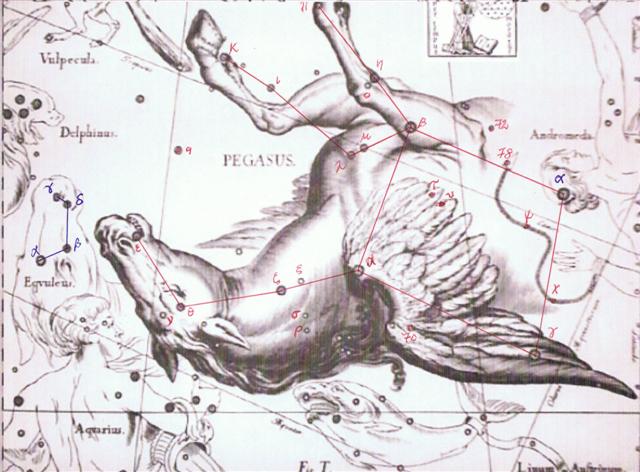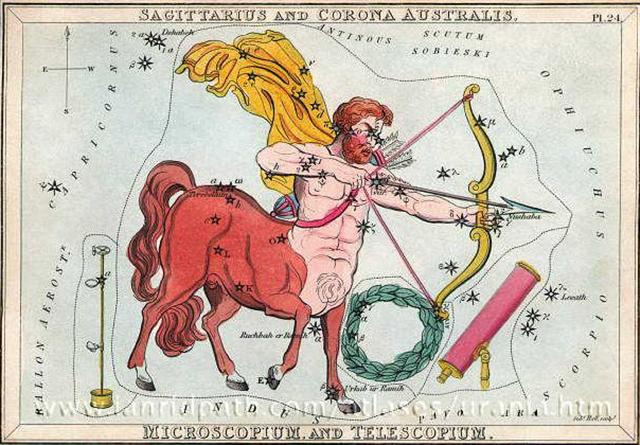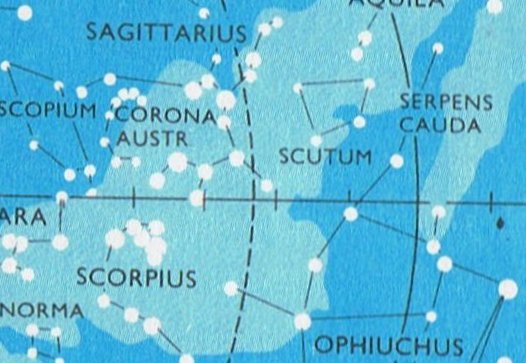Since the epoch of Bharani (around 41.4 / 365.25 * 26000 = 2947 years before the epoch of rongorongo or around 1100 BC) the fixed stars had apparently been pushed ahead due to the precession with ca 41 right ascension days. This could be used as an explanation for why the head was off both at Ga1-29 and at Ga3-11 - i.e. in the day after the solstice:
A new year was beginning and the old one had to be buried - be out of sight.
Simultaneously with the Sun reaching Tejat Prior (η Gemini at the left foot of Castor) the right front leg of the Archer Horse (η Sagittarii) was sacrificed at the Full Moon. June 21 (solstice) + 1 = June 22 (173) and 173 + 183 = 356 = December 21 (solstice) + 1.
The right front leg of the Archer Horse corresponded to the faint star ε Equulei about 41 right ascension days later:
In the Babylonian overview the archer horse Pabilsag was equipped with wings, which might have motivated drawing Sagittarius with a piece of cloth flying in the air:.
Behind the back of his head the Archer Horse (Sagittarius) had a string of stars, beginning at his neck:
A closer look at Pabilsag reveals there are many details to consider:
The Horse is simpler. ... When the man, Ulu, returned to his wife from his visit to the temple at Puueo, he said, 'I have heard the voice of the noble Mo'o, and he has told me that tonight, as soon as darkness draws over the sea and the fires of the volcano goddess, Pele, light the clouds over the crater of Mount Kilauea, the black cloth will cover my head. And when the breath has gone from my body and my spirit has departed to the realms of the dead, you are to bury my head carefully near our spring of running water. Plant my heart and entrails near the door of the house. My feet, legs, and arms, hide in the same manner. Then lie down upon the couch where the two of us have reposed so often, listen carefully throughout the night, and do not go forth before the sun has reddened the morning sky. If, in the silence of the night, you should hear noises as of falling leaves and flowers, and afterward as of heavy fruit dropping to the ground, you will know that my prayer has been granted: the life of our little boy will be saved.' And having said that, Ulu fell on his face and died. His wife sang a dirge of lament, but did precisely as she was told, and in the morning she found her house surrounded by a perfect thicket of vegetation. 'Before the door,' we are told in Thomas Thrum's rendition of the legend, 'on the very spot where she had buried her husband's heart, there grew a stately tree covered over with broad, green leaves dripping with dew and shining in the early sunlight, while on the grass lay the ripe, round fruit, where it had fallen from the branches above. And this tree she called Ulu (breadfruit) in honor of her husband. The little spring was concealed by a succulent growth of strange plants, bearing gigantic leaves and pendant clusters of long yellow fruit, which she named bananas. The intervening space was filled with a luxuriant growth of slender stems and twining vines, of which she called the former sugar-cane and the latter yams; while all around the house were growing little shrubs and esculent roots, to each one of which she gave an appropriate name. Then summoning her little boy, she bade him gather the breadfruit and bananas, and, reserving the largest and best for the gods, roasted the remainder in the hot coals, telling him that in the future this should be his food. With the first mouthful, health returned to the body of the child, and from that time he grew in strength and stature until he attained to the fullness of perfect manhood. He became a mighty warrior in those days, and was known throughout all the island, so that when he died, his name, Mokuola, was given to the islet in the bay of Hilo where his bones were buried; by which name it is called even to the present time ... The path of the ecliptic separated a flow of 4 stars - ο, π, ρ, υ:
|
||||||||||||||||||||||||||||||||||||||||||||||||||||||||||||||||








